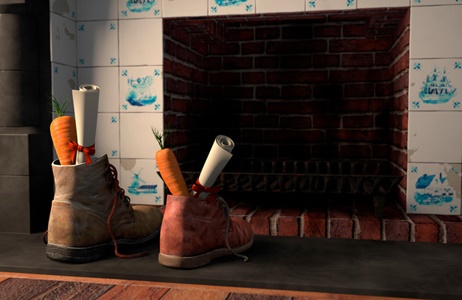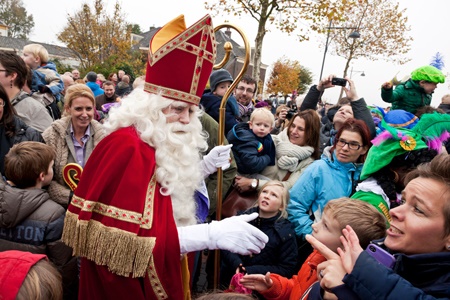
Today, most countries see Santa Claus as a round, giving and jolly man who delivers gifts to boys and girls around the world on Christmas Eve.
But before this image was popularised, the story of Saint Nicholas is a rather sombre one. In many European countries he travels with an evil companion and a whole day is celebrated in his honour.
Contrary to popular belief, Coca-Cola did not create the image of the Santa clad in red attire.
They did, however, popularise the image of Santa Claus around the world since the 1920s, when illustrator Haddo Sundblom was commissioned to illustrate an advertisement for Christmas.
Since then, Santa is portrayed as enjoying a glass of refreshing Coca-Cola while delivering gifts.
But the legend goes back even further.
The image of Santa dressed in red is a result of a poem written by Clarke Moore. ‘T’was the Night before Christmas’ was published in 1823 and describes Saint Nicholas and his eight reindeer.
Santa Claus is REALLY old
Saint Nicholas was a bishop in the 4th century in a region now known as Turkey. He was left orphaned when his wealthy parents passed away, however, they left him a lot of money.
He decided to dedicate his life to being charitable to his community, but he did it in secret. His identity was revealed when a poor father of three caught him leaving gold in one of his socks by the fireplace.
Legend has it that the father’s daughters were about to face a life of prostitution because their father could not afford to pay their dowries, but Saint Nicholas came to the rescue.
He begged the father not to tell anyone that he was the one leaving gifts for people, but obviously the old man spread the news. Since then, everyone who would receive anonymous gifts would think it was Saint Nicholas’ doing.
In later years, the Romans banned the Catholic Church and Saint Nicholas was arrested. He died on 6 December 343, two years after his release from prison.
The anniversary of his death is now celebrated and is known as Saint Nicholas day. Faiths that use the Julian calendar celebrate this day on 19 December.
Does he know Princess Ariel or Poseidon?

In Greece, Santa Claus is known as Ayois Vassileios and brings gifts to children on New Year’s Day. Saint Nicholas however, is the patron saint of sailors and seamen.
Legend has it that his clothes are soaked in brine, his beard is dripping with seawater and he's covered in sweat from fighting off the waves to help sailors have a safe journey.
Devotion to Ayois Vassileios can be seen on ships bearing an icon of the legend. The country's naval force honours him with a ceremony every year, carrying his statue to the harbour so he may bless their ships for their future voyages.
Households who have sailors in the family will name their sons Nikolaos in honour of the saint.
This legend could be worse than Hansel and Gretel!

In France, legend has it that Saint Nicholas saved three boys from an evil butcher! The boys had lost their way home when the butcher kidnapped them.
He had already soaked them in salt and was ready to make a meal out of them when Saint Nicholas helped them escape the butcher’s evil clutches.
Since then, the evil butcher named Père Fouettard, follows Père Noël (Santa Claus) around in shame. Père Noël visits children to give them gifts but children also fear that the butcher will convince Santa to skip them.
Children will polish their shoes and leave them by the fireplace so he can leave small gifts, fruits, nuts and cookies for them.
In the morning when they wake up, the shoes are filled! However, even the children who have been good get a ‘naughty’ gift of a bunch of twigs tied with a ribbon as no one is good all the time.
- Read also: teach your kids gratitude in 5 easy steps
He promotes good behaviour

In Poland he is known as Mikolaj. Children write to him to tell him if they’ve been good or bad and drop hints of the gifts they would like to receive from him.
According to the Polish folklore, he comes from heaven on a sleigh that is pulled by a white horse, and visits homes by the countryside. The children see him and recite prayers and their catechism to him.
If they have been good, he will praise them, reprimanding those who have been bad. He then gives out holy pictures, red apples or cookies. Even if he isn't seen, he leaves presents under children’s beds.
The children unwrap their gifts after dinner on Christmas Eve.
Santa's entourage is better... or scarier than yours!

Saint Nicholas day is the most popular day during advent in the Czech Republic. According to the story, Svatý Mikuláš (Santa Claus) was lowered down from heaven with a heavy gold cord by angels, bringing with him a basket of fruits, sweets and nuts.
On the eve of Saint Nicholas day, the story is brought to life in the streets of the country's cities and towns. A procession is formed which includes Svatý Mikuláš, who gives gifts, as well as devils and angels.
Svatý Mikuláš will quiz the children about bible verses, and the angel will write down their score. The devils threaten to take the children away but the angels protect them.
Good children receive stockings filled with presents while bad children receive coals or rotten potatoes.
Saint Nicholas then shares a toast with the parents.
Santa by another name would give just as much

The origin of Santa Claus perhaps stems from the Dutch name for Saint Nicholas: Sinterklaas. Every year in the Netherlands, the Sinterklaas parade is televised on St. Nicholas' Eve
He and his helper Zwarte Piet arrive on a streamer from Spain, riding through the town on a white horse. They then meet the mayor and are led by a brass band on a parade through the town.
Before St. Nicholas' Eve, Sinterklaas will visit children in schools and hospitals to determine if they've been good.
Children will put out their shoes by doors and windows with a letter, pictures and carrots for him and his horse.
Good children are rewarded with chocolate, money, a small gift and any other edible treats. Bad children receive bags of coal or salt.
The Dutch people make a big deal of St Nicholas eve with a huge feast, creative presents and practical jokes.
In recent years, a lot of controversy has surrounded the tradition of Zwarte Piet with many Dutch people of colour calling for the practice to be abolished as it is very insensitive.
While some regions in the Netherlands have done away with Zwart Piet, some still argue it is part of their heritage and that it has no racist connotations.
Saint Nicholas is still highly favoured by children all over the world. He encourages children to be good by rewarding them small gifts and reminds them that the spirit of Christmas is about love and charity.
Also read:
- Christmas traditions around the world.
- Lies about Santa? They could be good for your child.
- "Dear Santa, trust me I've been good bro."
Do you have any interesting Santa Clause stories to share? Tell us your story by emailing to chatback@parent24.com and we may publish your comments.




 Publications
Publications
 Partners
Partners














